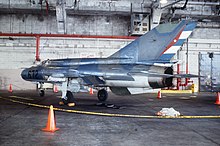Cuban Revolutionary Air and Air Defense Force
[5] The remaining operational aircraft were deployed against the Cuban exiles landings on 19 April, sinking one transport, the Rio Escondido and badly damaging another, the Houston, which was beached, resulting in the loss of most of the invader's supplies.
Although there is no exact figure available, Western analysts estimate that at least 130 (with only 25 operational)[9] of these planes are still in service spread out among the thirteen military airbases on the island.
In 1996, fighters from the DAAFAR shot down two Cessna aircraft based in Florida which were accused of dropping leaflets into Cuban airspace.
At San Antonio de los Baños military air field, south west of Havana, several aircraft are visible using Google Earth.
[12] Source:[14] The 2nd Guards "Playa Girón" Aviation Brigade, based in San Antonio de los Baños, is an elite unit of the DAAFAR.
The San Antonio de los Baños air base was built at the end of World War II.
[16] In October 2019, the regiment called for the immediate release of former Brazilian President and leader of the Workers Party, Luiz Inácio Lula da Silva.
[18] Prior to the Cuban Revolution, aircraft operated by the Air Force included: Vought O2U Corsair, Airco DH.4B, Curtiss JN-4D, Waco D-7, Bellanca Aircruiser, Howard Aircraft Corporation transports, Boeing-Stearman A73, Curtiss-Wright 19R-2, Grumman G21, Grumman G-21 Goose, Aeronca L-3, Boeing-Stearman PT-13, Boeing-Stearman PT-17, North American T-6, North American P-51D Mustang, North American B-25J Mitchell, Douglas C-47, Lockheed T-33A, Hawker Sea Fury, de Havilland Canada DHC-2 Beaver fixed-wing aircraft, and Westland Whirlwind (S-55) helicopters.



